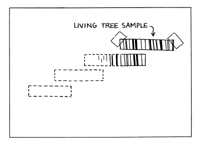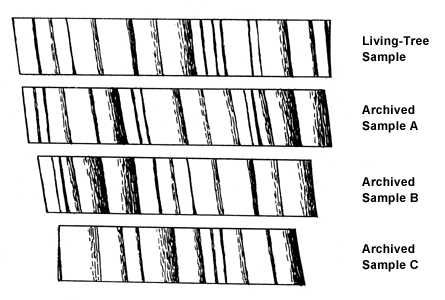Methuselah Tree
|  |
Student Handout |
Tree-Ring Science
Have you ever looked at a tree outside your house and wondered when it started growing? You can't tell how old it is just from looking at it, but you can tell from samples taken from within the tree. In this activity, you will analyze tree ring samples—all from the same area—and determine the age of the oldest sample.

Procedure
On the copy of this student handout, cut out each of the four tree-ring samples. Orient your blank sheet of paper horizontally. Tape the live tree sample in the upper right-hand corner. Now find the sample that matches part of the living tree sample. Line that up correctly and tape that sample down. Work from the top right-hand corner of the page to the bottom left-hand corner. Continue this process until you have used all the samples. Now count how many rings there are total, making sure to count the overlapped regions only once.
| 
Tree Rings
Trees start out small, and each year, they grow by one ring. By counting the rings from the middle of the trunk out to the end, a scientist can tell how old a tree is. One tree ring is added each year.
|
Questions
Write your answers on a separate sheet of paper.
If the living tree is 15 years old, how old is the oldest tree in your sample set? Predict why some rings are bigger and others smaller. Your samples represent trees with normal growth years. What are some factors that might contribute to abnormal growth? You looked at four samples, but scientists who study tree rings use many samples from the same area. Why might this be?

|

